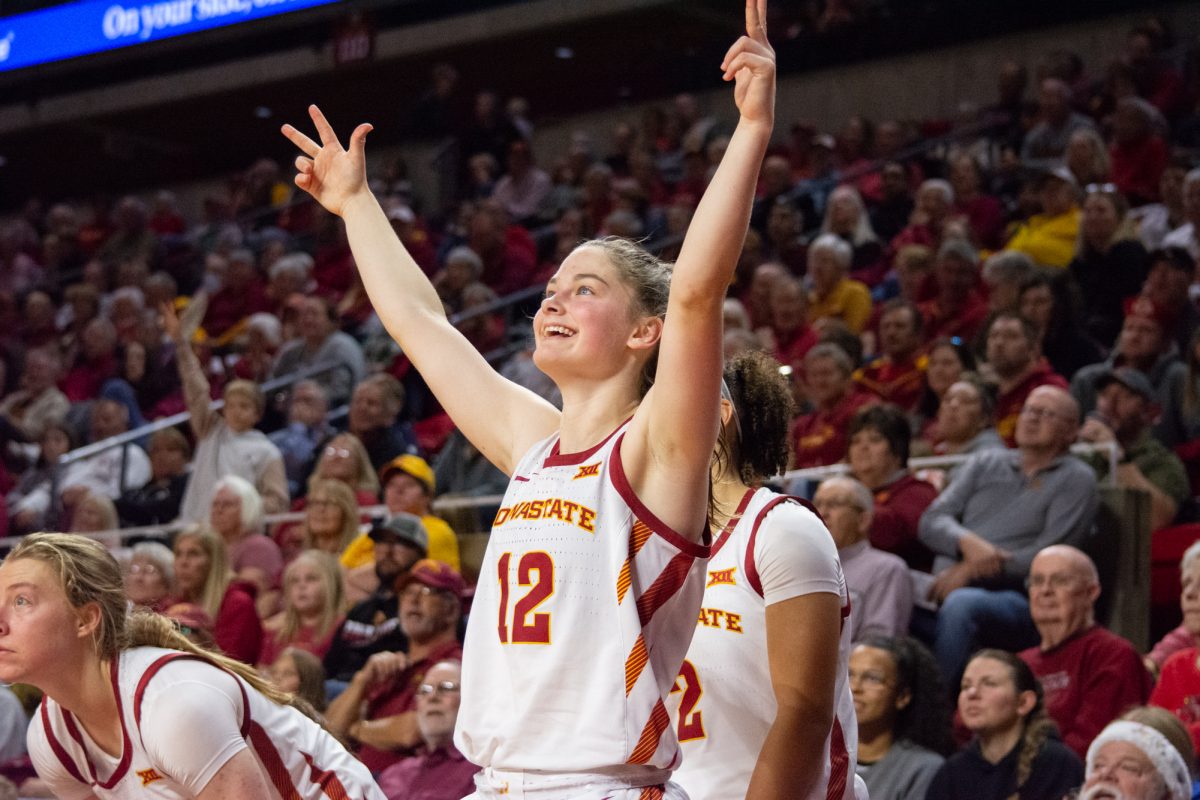Roland residents turn noses up to hog lots
November 18, 1998
“Oh God!” is the first sound out of Iowa State English instructor and Roland resident Michele Regenold’s mouth as she explains the stench of manure application in the fall.
Regenold, a close neighbor to a new hog confinement construction site, said she is worried about the potential problems associated with living near a confinement.
Regenold is not alone in her concern; Earl Sime, the Roland farmer who is the closest neighbor to the confinement, also is worried.
“Even if the smell is not there, you still have the dander, hair [and] carcinogens,” Sime said.
Sime said hog lots have started surrounding Roland, his hometown of 57 years, and this newest confinement is too close to home. He has proclaimed himself as the biggest fighter of the confinement.
Regenold and Sime agreed that the number of hog confinements near Roland is increasing, and they aren’t happy about the situation.
“Raising hogs in large confinements is not a way to build community — it takes away the farm-family approach,” Regenold said.
As Sime looked at the confinement’s skeletal structures, he shook his head.
“I wish he wouldn’t have done it,” Sime said.
“He” is one of Sime’s longtime acquaintances, Lon Strum, who currently is building a 3100-hog operation.
“I have no reason to hate [Strum],” Sime said. “He’s my classmate. I’ve known his family all along.”
Regenold said being surrounded by hog lots prompted her to fight back by signing a petition that Sime created in protest to the confinement.
Strum said the petition won’t stop him from building, however.
“I’m still going to do everything the best that I can — they need to
accept this,” Strum said.
This fight between neighbors and hog operations has become a heated struggle in the quiet, sloping fields of Southeast Hardin County. However, new ISU research with odor-controlling techniques may be the key to ease the fears for neighbors of hog confinements in Hardin County.
Jeff Lorimor, assistant professor of agriculture and biosystems engineering, conducted a field trial to evaluate different methods of controlling livestock odor.
After studying nine different techniques, Lorimor recommended three methods: biocovers, synthetic covers and soil injection. He chose these methods based on their odor control effectiveness and their low cost.
Lorimor said the soil injection method, which involves machine-incorporating manure into the soil, “works well and saves nitrogen.” However, this method is only used during the fall for fertilizer.
The cover methods, biological and synthetic, both work on the principals of physically masking the odor. According to Iowa State’s Extension home page, “Biocovers consist of fibrous biological materials such as straw or chopped cornstalks blown on top of liquid [manure] storage units.”
Lorimor said the covers dramatically reduced odor emissions from livestock operations in his field trial.
Brad Moeckley, an Elkhart farmer involved in Lorimor’s field study, said he was “really pleased” with the synthetic cover used on his operation.
Moeckley has 500 hogs on his farm and an 8-foot-deep, 70-foot-wide manure pit.
“[The manure pit] was putting off a lot of odor,” Moeckley said. When Lorimor approached him for the study, Moeckley said he was willing to give the cover a try.
Moeckley said when people drive by his operation now, they say, “Wow, it smells better!”
Peggy Lockhart, manager of the Olfactometry Laboratory, and Dwaine Bundy, professor of agriculture and biosystems engineering, also are looking for solutions.
Located in Davidson Hall, ISU’s odor testing laboratory uses the human nose to analyze odorous air collected from various livestock facilities.
The olfactometery panel consists of five students and an olfactometer, a machine that delivers odorous samples from a Tedlar gas-sampling bag to a sniffing port.
Following guidelines set by the American National Standards Institute and the American Society for Testing and Materials, the panelists sniff each diluted odor sample as it is discharged from one of three olfactometer ports.
The panelists must then select one of the three sniffed ports that emitted a different odor from the others. The panelists must state if their choice was a “guess,” “detection” or “recognition” of the odorous air, following ASTM guidelines.
Dan Wisedom, panelist and senior in management information systems, said he joined the panel because he thought it would be an easy way to make money.
“I saw a sign that said [panelists would] sit around and study and get paid for it,” Wisedom said.
Lockhart said the panelists didn’t have many criteria to meet.
“There is only one question they have to pass to get the job,” Lockhart said. “Are you offended by livestock odors?”
The panelists, who can usually be found lounging in the olfactometery laboratory, seem to have a sense of humor regarding their work.
“The best part about the job is telling your friends you smell poop,” Wisedom said.
Wisedom said the hardest part of his job is “figuring out what to put on your r‚sum‚.”
While Lockhart oversees the testing of odorous air in the laboratory, Bundy, a colorful authority on livestock odor, analyzes problem livestock operations and serves as reference in nuisance allegations.
When testing a facility for nuisance odors, Bundy said he puts his nose to work downwind of the operation by using a scentometer.
Bundy said this device is used to measure odor thresholds with ratios of 1/2 to 1/32. The higher the ratio, Bundy said, the more fresh air is mixed within the odorous air.
Bundy said the reason he uses the human nose as a measuring device despite the availability of state-of-the-art equipment is the same reasoning behind Kennedy Airport’s use of dogs to sniff baggage. He said the nose can detect, at low levels, what machines cannot.
Neighbors such as Sime and Regenold do have protection under Iowa law to fight against nuisance odor, a constant odor that interferes with their pursuit of happiness and use of property.
Bundy has been involved in debates over a recently proposed legislation, House Bill 519, that would protect hog producers from nuisance odors in an agricultural area.
House Bill 519 was shot down in the Iowa Congress, being ruled as unconstitutional. Bundy said if the bill had passed, it could have meant “potentially more lawsuits.”
Strum said he is concerned about the possibility of lawsuits filed by his neighbors.
“I’m concerned, but I’m not going to lose sleep on it,” Strum said.
Sime sighed as he pulled his work boots on with the help of pliers found in his coat pocket.
“I’m like anyone — hoping for the best,” he said.






